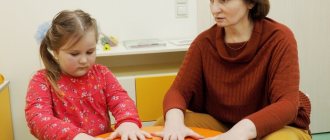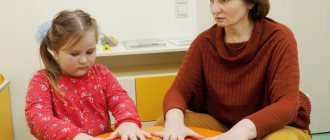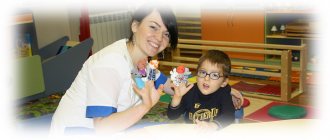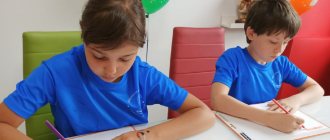Consultation with a neurologist – RUB 1,750.
- Symptoms
- Diagnostics
- Treatment
Dysarthria is a speech disorder consisting of distortion and difficulty pronouncing certain words or sounds. With this disease, a restriction in the mobility of the speech apparatus is formed as a result of a violation of its innervation due to damage to the central nervous system.
Possible causes of the development of pathology include:
- birth injuries and asphyxia;
- previous meningitis, meningoencephalitis;
- history of traumatic brain injury;
- severe long-term intoxication;
- brain tumors;
- neurosyphilis.
There are several forms of dysarthria:
- bulbar form - occurs when pathology forms in the nuclei of the cranial nerves in the medulla oblongata;
- pseudobulbar form - the pathways connecting the cerebral cortex and nuclei are affected;
- subcortical form - the lesion is located in the subcortical nuclei;
- cortical form - the cerebral cortex itself is directly affected;
- cerebellar form - the pathology is localized in the cerebellum and affects its pathways.
Symptoms
Depending on the severity of speech disorders, four degrees are distinguished:
1st degree of severity – there is no pronounced pronunciation defect, deviations from the norm can be identified during examination by a speech therapist;
2nd degree of severity – speech intelligibility is preserved, but some disorders are already becoming noticeable;
3rd degree of severity - the speech of a sick person is understandable not only to close people, but also to some strangers;
Grade 4 severity – the patient’s speech is absolutely incomprehensible.
The clinical picture of dysarthria is characterized by general symptoms:
- distortion of sounds, words, syllables;
- facial muscle tension;
- limitation of mobility of the articulatory apparatus (lips, tongue);
- salivation;
- weak voice;
- shortening of exhalation.
Modern studies of dysarthria in domestic and foreign speech therapy
Dysarthria, as a complex speech defect, is being intensively studied and covered by domestic and foreign scientists, various methods, diagnostic and correction techniques are being developed, this topic remains relevant in domestic and foreign speech therapy. Dysarthria as a specific disorder of the sound-pronunciation aspect of speech is caused by insufficiency of innervation of the articulatory, vocal and respiratory apparatus [1].
The scientific approach to the study of the problem of dysarthria was first applied by the German neurologist Little. While studying this disorder in children, he described speech disorders characteristic of dysarthria. The term “dysarthria” itself was first introduced by A. Kussmaul, by which he understood all violations of the phonetic side of speech in children and adults. And only in the middle of the twentieth century, dysarthria will be considered as a complex speech defect, in which not only the phonetic, but also the prosodic side of speech is impaired [2].
Speech disorders of a dysarthric nature can occur with various organic brain lesions that are formed under the influence of unfavorable factors during sensitive periods of child brain development. Unfavorable factors in the development of the nervous system include the pathology of pregnancy: chronic endogenous diseases of a pregnant woman, exposure to radiation, the harmful effects of alcoholism, fetal trauma and a number of other pathogenic factors. In the natal period, dysarthria can be caused by such pathophysiological phenomena as rapid or protracted labor, weakness of labor in pregnant women, asphyxia of newborns, etc. Also in the pathogenesis of the etiology of dysarthria, a large share is occupied by neuroinfectious diseases in children, traumatic brain injuries, severe somatic diseases that occur with complications in the central nervous system [3].
In Russian speech therapy science, speech-language forms of dysarthria have been identified and described, taking into account the leading neurological syndrome.
Focal damage to the motor cranial nuclei of the brainstem causes the bulbar form of dysarthria. The main pathological manifestations of a neurological nature are muscle weakness, decreased tone, weakening of voluntary and involuntary articulatory movements. External speech is pronounced blurry, sounds that are close in acoustic similarity are mixed.
With bilateral focal lesions of the pyramidal tract, a pseudobulbar form of dysarthria occurs. Symptoms of which occur in the form of bilateral paralysis of the muscles of the speech apparatus.
Damage to the cerebellum causes the cerebellar form of dysarthria. Cerebellar dysarthria is characterized by atony of the muscles of the entire speech apparatus and decreased tone of the articulation muscles. As a result, scanned pronunciation of speech occurs, slowness and jerkiness of the formation of speech elements [4].
Subcortical dysarthria occurs as a consequence of damage to the subcortical nuclei of the brain. This form is characterized by a violation of spatial coordination of the articulatory organs, changes in muscle tone in the speech organs, and changes in movements such as hypokinesia and hyperkinesia in the articulatory muscles.
The most difficult in terms of manifestations and differentiation possibilities is cortical dysarthria. It is formed when the secondary motor zones of the left hemisphere of the cerebral cortex are damaged. There are efferent and afferent forms. With the efferent form of dysarthria, all movements responsible for sound pronunciation are difficult, most often they break up into separate motor elements. With afferent dysarthria, spastic disturbances in muscle movement and paresis of speech muscles appear.
In the pediatric clinic of dysarthria, the presented forms are distinguished conditionally, since their neurological symptoms occur against the background of residual cerebral phenomena [2].
The degree of manifestation of dysarthric disorders of neurological and speech syndrome depends on the nature and severity of damage to the child’s central nervous system. In the studies of E.F. Arkhipova revealed that the severe form is most often found in children with cerebral palsy. Anarthria is characterized by a complete absence of phonetic pronunciation abilities. It is observed against the background of paralysis of the muscles of the speech apparatus. According to the severity of its manifestations, anarthria can vary (I. I. Panchenko): complete absence of spoken speech and voice; only vocal reactions such as humming; the presence of sound-syllable activity, such as babbling manifestations [6].
Average degree of dysarthria is more common in children with intellectual development delays of various etiologies. With this severity of the disorder, there are disturbances in the clarity and accuracy of speech pronunciation, it is slurred and difficult to understand, and there are distortions of several groups of phonemes. There are changes in phonation, the voice is unmodulated, causing speech to become monotonous.
Children with general speech underdevelopment (50-80%) and phonetic underdevelopment (30-40%) exhibit a mild degree of dysarthria [5]. E.F. Arkhipova introduced a term to designate such a disorder of sound pronunciation as “erased” dysarthria. The main manifestations of the latter are minor paresis of the articulatory muscles. The speech of a child with such a pathology is quite understandable for others, but existing sound pronunciation disorders manifest themselves in distortions and substitutions of some sounds for lighter ones. Most often these are phonemes formed in late ontogenesis.
In general, when characterizing speech disorders in dysarthria, domestic speech therapists note general signs characteristic of this polymorphic syndrome: disturbances in sound pronunciation, insufficiency of articulatory motor skills, changes in speech breathing, phonation and prosodic aspects of speech [7].
O.G. Prikhodko clarifies the characteristics of dysarthric disorders and notes the persistent nature of sound pronunciation disorders in children, as well as specific difficulties in automating sounds when correcting them [8].
The works of all specialists in the field of dysarthria note the leading signs of a neurological nature that explain the specifics of speech disorders and characterize the differential symptoms of dysarthria. Marked weakening of muscle contractions, pareticity of the speech apparatus, difficulty maintaining a closed mouth posture, lack of pronounced tension in the muscles of the lips and tongue. When performing articulatory movements, muscle flaccidity increases, movements quickly fade away, and become exhausted.
There may be a state of increased tone in some muscles. The phenomenon of spasticity manifests itself in the difficulties of the child’s facial reactions, tension of the lips and tongue. There are involuntary movements of the speech muscles, hyperkinesis manifests itself in the form of trembling of the tongue, lips, facial muscles, and vocal folds. In almost any form and degree of manifestation of dysarthria, hypersalivation phenomena are observed. Increased salivation occurs, especially when performing speech movements [5].
A pronounced sign of dysarthria is a violation of phonation characteristics. Voice reactions in dysarthria are characterized by insufficient strength, nasalization of the voice and changes in modulation are observed [9,10].
Speech breathing disorders are associated with insufficient volume of exhaled air, as well as impaired coordination of speech exhalation. The speech flow of air is weak; frequent, untimely intake of air is produced when pronouncing words and phrases [11].
The above symptoms of a neurological nature of speech disorder in dysarthria cause persistent disturbances in the melodic-intonation and tempo-rhythmic design of coherent speech. With this form of speech dysontogenesis, changes in voice timbre and difficulties in voluntary reproduction of differentiated intonation elements are observed. Children with dysarthria experience difficulties in identifying and placing logical stress in words and phrases, and organizing correct pausing of statements. They have poor speech intonation, rhythmic inconsistency of speech during communication, and motor incoordination of the speech apparatus [12].
Thus, dysarthria is a type of speech dysontogenesis, which manifests itself in a violation of motor speech implementation. The concept of dysarthria is considered in clinical, speech therapy, psychological and linguistic aspects. Today, in speech therapy, the structure of speech defects has been described, classifications and priority directions for studying this issue have been developed.
Treatment
Correction of the disease is carried out with the help of speech therapy sessions. Under the supervision of a doctor, fine motor skills and speech motor skills improve. In addition, the neurologist prescribes medication and rehabilitation therapy. Rehabilitation therapy includes:
- physiotherapy;
- exercise therapy;
- acupuncture;
- medicinal baths;
- reflexology.
Drug treatment means the prescription of nootropics.
Prevention of pathology consists mainly in early diagnosis of speech disorders and their correction. It is also necessary to try to avoid or promptly treat brain injuries and intoxication of the body.
Speech and non-speech symptoms of dysarthria
Speech symptoms
:
1) Violation of voice formation.
2) Violation of sound pronunciation (almost all groups of sounds). Depending on the degree of damage, the pronunciation of all or several consonants may be affected. The pronunciation of vowel sounds may also be impaired (they are pronounced unclearly, distorted, often with a nasal tint).
3) The so-called speech prosody suffers (a set of rhythmic and intonation means of speech), including: timbre (dull, hoarse, monotonous, compressed, dull; can be guttural, forced, tense, intermittent, etc.); voice strength; pace; pause; rhythm; modulation (the child cannot arbitrarily change the pitch); logical stress; speech breathing; intonation; emotional coloring; flight of voice; diction and general melody of speech. It is the prosodic components that determine the expressiveness, intelligibility of speech, and its emotional impact in the process of communication.
4) Impaired perception of phonemes (sounds) and their discrimination. It occurs as a result of unclear, blurred speech, which does not allow the formation of a correct auditory image of sound.
5) Violation of the grammatical structure of speech and poor vocabulary.
Non-speech symptoms.
Dysarthria is characterized by the presence of non-speech symptoms to varying degrees, complicating the process of speech acquisition:
1. Paresis and paralysis of the muscles of the trunk and limbs, speech muscles
. Due to paresis, the child is severely or completely limited in movement, which leads to a violation of visual-spatial representation, since children perceive space “by the measure of their own steps”; paresis of the speech muscles interferes with the normal pronunciation of sounds.
2. Impaired cognitive activity:
due to limitations caused by paresis and paralysis of the hands, the child cannot fully engage in knowledge of the surrounding world, because holding objects in his hands, bringing them to his mouth, trying to “taste”, the child gains understanding about surfaces (smooth, rough), shapes, sizes, temperature (cold, warm), etc.
If the child does not gain an understanding of the various characteristics of objects (spatial, textured, etc.), this will cause difficulties in indicating these characteristics in words. Those. The child will not be able to tell on his own whether an object is further away or closer to him, which object is lower, which is higher, etc.
Paresis of the extraocular muscles also leads to a delay in the development of a child’s cognitive activity. In cases of this type of paresis, functions such as stopping the gaze on an object, “studying” it with the gaze, “tracking” a moving object, and quickly searching for an object with the eyes are disrupted. This can develop into specific impairments in writing and reading, and difficulties in mastering drawing, geometry, geography, drawing, and other subjects.
3. Emotional-volitional disorders
, depending on the area and time of brain damage, has varying degrees of severity and features of manifestation
4.Secondary mental layers
. Usually associated with the child’s feelings about his inferiority.
All these symptoms have an additional negative impact on the state of the child’s speech and the progress and effectiveness of correctional work with him.
Chapter 6. Main directions of comprehensive rehabilitation of children and adolescents with dysarthria
- Principles of rehabilitation of children with dysarthria
- The main directions of speech therapy work on the correction of speech disorders with dysarthria in preschool children
6.2.1. Normalization of muscle tone, development of motor skills of the articulatory apparatus and fingers
- Development of respiratory function and voice
- Correction of the phonetic side of speech
- Development of vocabulary and grammatical structure of speech
- Specialized correctional work with primary schoolchildren with dysarthria studying in a comprehensive school
- Specialized comprehensive correctional work with adolescents with dysarthria










